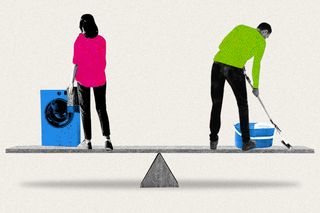
Partners Tend to Divide Chores – But Sharing the Same Tasks Could Be Healthier
Even though splitting chores may sound egalitarian on the surface, “when it comes down to it, those tasks are not equivalent.”

It’s a universal truth — unearthed from a colossal patriarchal weight — that how labor is divided in relationships impacts the overall dynamic. But labor in itself varies; cleaning the bathroom comes with its own murkiness which purchasing groceries doesn’t. Just like taking care of a child is not the same as paying the bills.
Chore wheels, to-do lists, a 50-50 split of taking responsibility for different aspects of household work — these are all then ambitious ways to strike happiness and equality in a relationship, but are not always the most effective. What of a scenario where partners “share” the same kind of work (not the same as doing things together) — in that both are equally accountable for, say, cleaning the dishes? Splitting would then mean dividing chores by virtue of the task; sharing, on the other hand, may entail partners alternatively doing the same activity. Monday-Wednesday-Friday person X does the dishes; the responsibility falls on person Y on the other days.
“It turns out that the more tasks couples share together, that they do jointly, the greater their feelings of equity, the more satisfied they are with their housework arrangements,” Daniel L. Carlson, Associate Professor, Department of Family and Consumer Studies, University of Utah, author of the study, said in a research brief. To be published in the journal Sex Roles, the new research shows where couples (the research only studied behavioral patterns in heterosexual relationships) get it wrong. It is only when partners “shared” their workload that they found an improvement in their relationship. The research, along with what we know about power dynamics and gendered responsibilities, presents an interesting — and sustainable — format of an egalitarian relationship.
“Dividing up tasks is good for factories. Sharing tasks is better for families,” as Belinda Luscombe wrote in TIME.
Carson analyzed national surveys of married people in heterosexual relationships in the U.S.; mapping the degree to which partners share housework. The two categories were partners who either divided the household work equallybut which differed in terms of tasks and those who took (“shared”) equal responsibility for every chore. The subsequent questions were about how they felt about the relationship (was it fair? were they satisfied with the household arrangement). People in an egalitarian relationship — defined as different from a “traditional” one where gendered roles still prevail — were more satisfied than couples who each took on individual chores and didn’t share any of them. “The number of equally shared tasks matters a great deal for both men’s and women’s relationship quality,” Carlson concluded.
How does sharing the same tasks help the relationship, more than say dividing tasks? The rationale for this seems intuitive at first — familial labor in itself skews heavily in some directions and light on others. “Some [housework] are more enjoyable than others. Some are more isolating than others,” as Carson explained. “I might get the three easy ones, the more fun ones, and you might get the three harder ones. So even though we’re kind of splitting it up on the surface, when it comes down to it, those tasks are not equivalent.”
There are multiple socio-cultural reasons that determine the semantics here. But the bigger takeaway seems to be purely focusing on the number of hours spent doing XYZ things is ignorant at best, disrespectful at worst.
Related on The Swaddle:
Long‑Term Couples Can Develop Biological Similarities, Shows Study
Moreover, doing the same thing, and taking accountability for it, helps fill in the ideological blind spots. Research has long shown that partners’ happiness is closely linked to how “fair” an individual feels they are treated in a relationship. “If they’re sharing tasks rather than splitting them up, I can envision that it’s making visible all the invisible things that they may take for granted,” said Joanna Pepin, an assistant sociology professor at the University of Buffalo, New York, who was not involved in the study.
To Pepin, the findings at first seemed “counterintuitive.” The narrative has focused on a 50-50 sharing of housework as the ultimate way to strike equality and happiness in relationships. But that premise lacks incentive as well as evidence.
Scholars have long agreed that unfairly distributing work hurts a relationship. In a traditional marriage, where the male partner earns a livelihood while the female partner takes charge of the home, researchers have documented higher feelings of “fairness.” This is because the expectations match with the outcome — the relationship reflects the idea of both partners’ family life.
But in an egalitarian setting where both partners are working and have signed on to equally “divide” responsibilities, satisfaction levels are still skewed. Women may not be the ultimate “admin” coordinator of the home, but even in the most egalitarian heterosexual marriages, female partners continue to shoulder the bulk of childcare and housework responsibilities. In the pandemic itself, even in households where both parents were working, mothers evidently found themselves foregoing professional opportunities for caregiving responsibilities.
“Women’s roles have changed so much and we are kind of trying to figure out what the incentive is for men to take up more of the labor at home,” Pepin told TIME. “This is a really smart approach to thinking about why we might be stuck in getting to more equality in relationships.”
As Carson noted: “Men may be equally satisfied doing no housework or sharing all or most tasks equally, but since women’s highest satisfaction is when all or most tasks are shared, the route to a happy relationship appears to lie in sharing.”
Saumya Kalia is an Associate Editor at The Swaddle. Her journalism and writing explore issues of social justice, digital sub-cultures, media ecosystem, literature, and memory as they cut across socio-cultural periods. You can reach her at @Saumya_Kalia.
Related


Body Matters: The Taboo Around STI Testing
